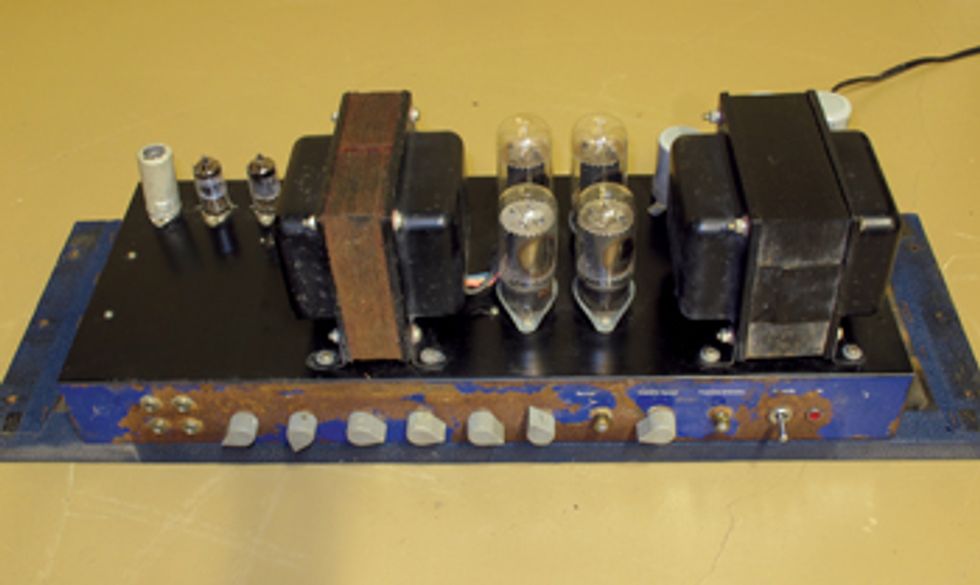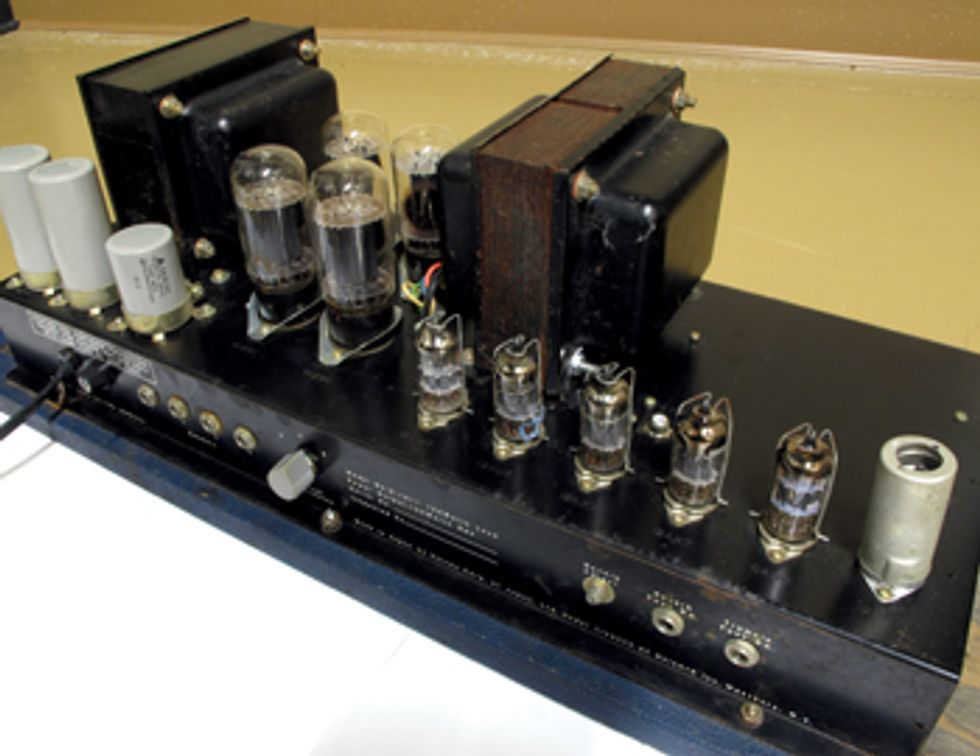
A well-worn U1040 out of its cabinet.

The U1040’s back panel includes jacks for both reverb and tremolo footswitches.
Hi Jeff,
It’s probably a lingering artifact from
some emotional turbulence years ago,
but I’m fond of the goofy, early-’70s,
two-tone blue Univox amps with the
orange logos. I bought a weary, nonworking
U1040 project off Craigslist
and have been trying to nurse it back
to health. A local shop got it to pass
signal and technically function, but
with four power tubes, some big-bruiser
transformers, and a rating of 105
watts, I was expecting more. The amp’s
volume seems weak and muted, its
tone is nothing special, and the whole
thing just seems sonically constipated. I’ve been told this amp has an
unusual design. What remedy might
the amp doctor prescribe for this lackluster
combo?
Best regards,
Tom Shaw
Hi Tom,
Although I’ve never owned one, I absolutely
remember these cool and unusual-looking
amps. According to the Univox site, your
1040 Quad Reverb was one of a large contingent
of models designed and marketed
in 1971. Although Univox was originally
a Japanese company, around the time your
1040 was produced, these amps would have
probably been assembled in Westbury, New
York, using Japanese-built chassis. This model
was also available with a 4x10 speaker configuration
(U1044). These amps sold for $480
at the time, which was a pretty decent chunk
of change considering that a Volkswagen
Beetle was selling for under $2,000.
Although this 1040 model exists, apparently its schematic does not—at least online. So as a reference, I chose a schematic for another model with the same basic specs, the 2-channel 1010. It has 10 tubes, a solid-state power supply, reverb, tremolo, presence, and a 105-watt RMS output. My guess is this will be almost identical to your model.
When troubleshooting older amps with no known history, it makes sense to start with the tubes. Used or abused output tubes can certainly leave an amp with lackluster performance. Install another set of 6L6s and see if this makes a substantial difference. If so, have the new tubes biased properly for optimal performance. I’d also substitute each preamp tube and listen for an improvement. This may be a case where each tube replacement brings the amp another step towards proper performance.
While there are a few atypical design elements, there’s really nothing too “unusual” about it. The most noticeable difference is that the unit uses a 6AN8 triode/pentode tube in the reverb circuit. The pentode half of this tube feeds the triode half, which is basically a 12AU7, and the triode side drives the reverb tank. A little out of the ordinary, but certainly not an area that should be causing amp anemia. The following design differences, however, could be possible suspects.
The power supply differs from what’s normally found in the majority of guitar amps. In most guitar amplifiers, the power-supply voltages that are fed to different stages of the amplifier are all derived, in one way or another, from the main supply voltage, traditionally called B+. But in this design, the power supply is actually split into two discrete sections. The full power supply (650V DC) is feeding the plates of the output tubes, while the rest of the amplifier is fed with exactly one half of that voltage (325V DC), which is sourced at the center of the power-supply filter stack.
Most Music Man amps used a very similar design, but since the preamp stages of the Music Man were all solid-state, the half power-supply voltage was only used to supply the screen grid voltage to the output tubes, and here is where a potential problem could exist in your amp. The half voltage is derived at the center point of two series capacitors. If these capacitors are worn, dried out, and out of balance, the half voltage could be substantially low and cause weak output from the output tubes, as well as lower gain in the preamp stages.
Check the half voltage. If it’s substantially low, replacing these two 100 μF 450V capacitors could bring the amp back to life. And while you’re at it, I’d replace all of the filter caps, as their performance could be questionable as well.
Next, I’d look at the output stage. In most designs, the plates of each pair of output tubes on either side of the output transformer are connected together. In this design however, the plates are separated by a 100 Ω resistor. If those resistors have failed, you may only be getting output from two of the four output tubes. Replacing those resistors should enable all four tubes to operate again.
If none of the above potential causes are the source of the lackluster performance, I’d finally suggest looking at the speakers. Over the years I’ve seen many instances where the original speakers in vintage amps can become weak and worn out, and the amp sounds and feels completely underwhelming. Disconnect the internal speakers and play the amp through a good extension cabinet. New speakers can make all the difference in the world.
Warning: All tube amplifiers contain lethal voltages. The most dangerous voltages are stored in electrolytic capacitors, even after the amp has been unplugged from the wall. Before you touch anything inside the amp chassis, it’s imperative that these capacitors are discharged. If you are unsure of this procedure, consult your local amp tech.
 Jeff Bober is one of
the godfathers of the
low-wattage amp revolution,
co-founded and was
the principal designer for
Budda Amplification. Jeff recently launched EAST
Amplification, and he can be reached at
pgampman@gmail.com.
Jeff Bober is one of
the godfathers of the
low-wattage amp revolution,
co-founded and was
the principal designer for
Budda Amplification. Jeff recently launched EAST
Amplification, and he can be reached at
pgampman@gmail.com.














![Rig Rundown: AFI [2025]](https://www.premierguitar.com/media-library/youtube.jpg?id=62064741&width=1245&height=700&quality=70&coordinates=0%2C0%2C0%2C0)












 Shop Scott's Rig
Shop Scott's Rig